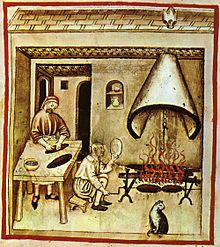Rotisserie
The rotisserie is an aid for grilling or roasting . Today it is operated either manually or electrically and can stand horizontally or vertically. The constant rotation means that the roast is heated evenly. In addition, less fat drips off, but runs over the meat and ensures a good crust .
history
Historical forerunners of the electric rotisserie spit were the so-called roast turner , which turned the roast on a skewer with the help of a mechanism during the roasting process in the open fire to ensure that the meat was evenly cooked.
A rotisserie is mentioned for the first time in writing in the middle of the 14th century in the biography of a French chef under the name tournebroche . Leonardo da Vinci constructed such a device around 1480 . On the title page of the cookbook Die Küchenmeisterey , published around 1487, a so-called Rauchbrater can be seen.
In the kitchens of the common people, the skewers had to be turned by hand for a long time. A kitchen boy was responsible for this in upscale households. There is a corresponding representation in the book of good Spis from the year 1350. There have also been attempts to drive the roasting spit with the help of treadmills that were kept going by dogs, or with the use of water power.
There were three different forms of mechanical rotisserie which were driven by a gear train , similar to a clockwork . In the so-called weight fryer, a weight attached to a rope drove the gear train, which ran over a drum. In the 15th century, the spring roaster represented an improvement, in which the weight was replaced by a spiral spring that was stretched in the lower drum and wound with a rope wound over the upper drum. The third variant was the Rauchbrater or Windbrater , which were also developed at this time. They were driven by a wind turbine by the smoke rising from the open hearth . In 1803, the Frenchman Coteau invented a steam-powered rotisserie.

Tacuinum sanitatis : hand-operated skewer, 14th century
|

Weight-driven rotisserie at Chenonceau Castle
|

A dog in the running wheel moves the rotisserie. Engraving by Thomas Rowlandson , 1800
|
In England, the use of dogs to keep the spatula going with the help of a running wheel was widespread well into the 19th century. The wheel was called the dog-wheel . For this use, a particularly suitable breed of dog with short legs was bred, which was given the official name Turnspit Dog ("rotisserie dog") and was similar to the Corgi . Larger households, in which roast roast was prepared daily , had several of these dogs, which were used alternately on a daily basis. The cooking time of a larger roast could be around three hours. Today this breed is extinct, because after the advent of modern rotisseries it was no longer needed and no longer bred.
dishes
- roast Chicken
- Doner kebab , shawarma
- Gyros , Kontosouvli
- Mechoui
- Spit roast
- Suckling pig
swell
- ↑ a b Uhrenstube Aschau: History of roast turner ( Memento of the original from August 24, 2016 in the Internet Archive ) Info: The archive link was inserted automatically and has not yet been checked. Please check the original and archive link according to the instructions and then remove this notice.
- ↑ a b Gertrud Benker, In old kitchens. Establishment-device-culinary art, Munich 1987, p. 39 f.
- ↑ "Whiskey" the turnspit dog ( memento of the original from October 2, 2007 in the Internet Archive ) Info: The archive link was inserted automatically and has not yet been checked. Please check the original and archive link according to the instructions and then remove this notice.
- ↑ BBC: Turnspit - Every dog has his day

